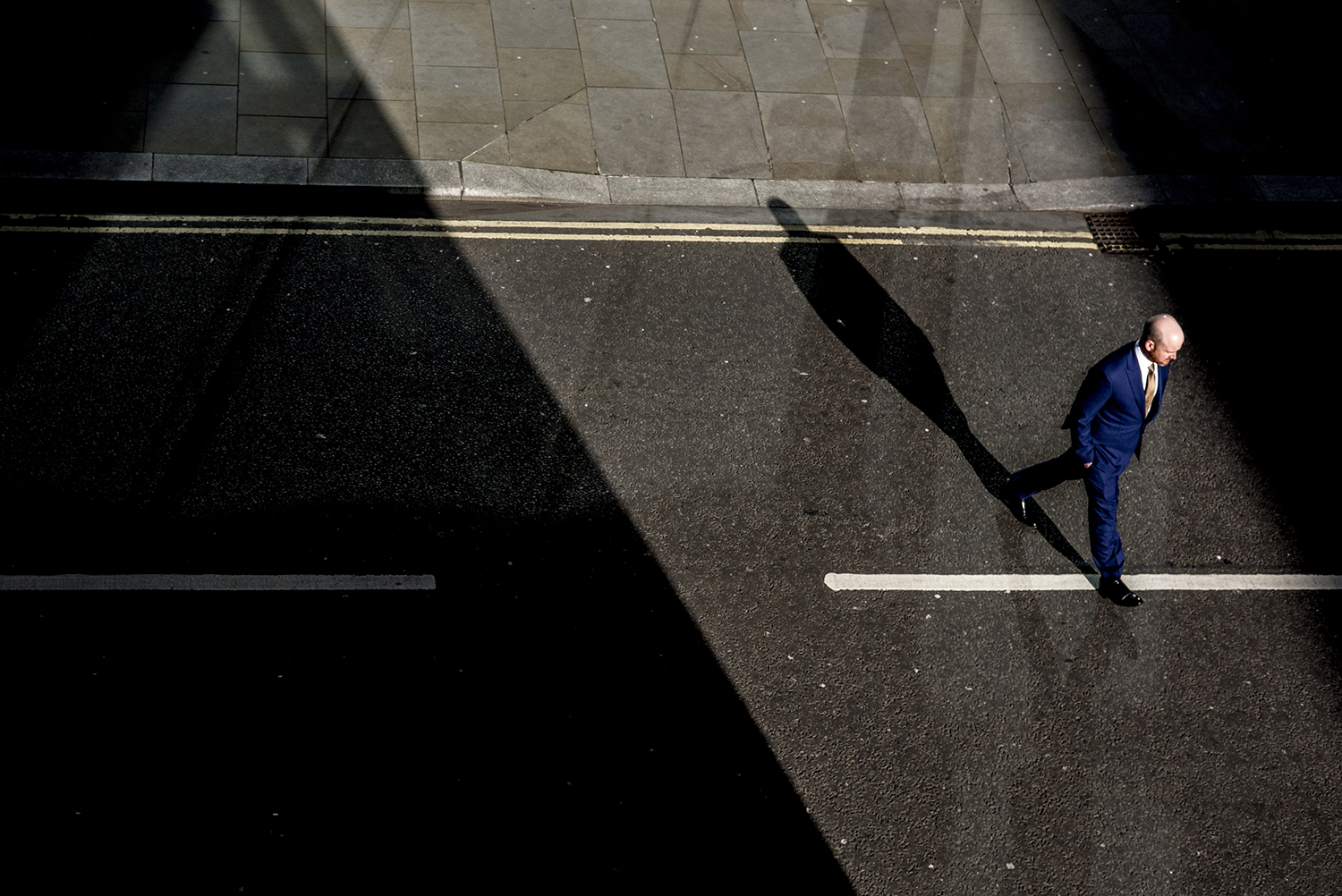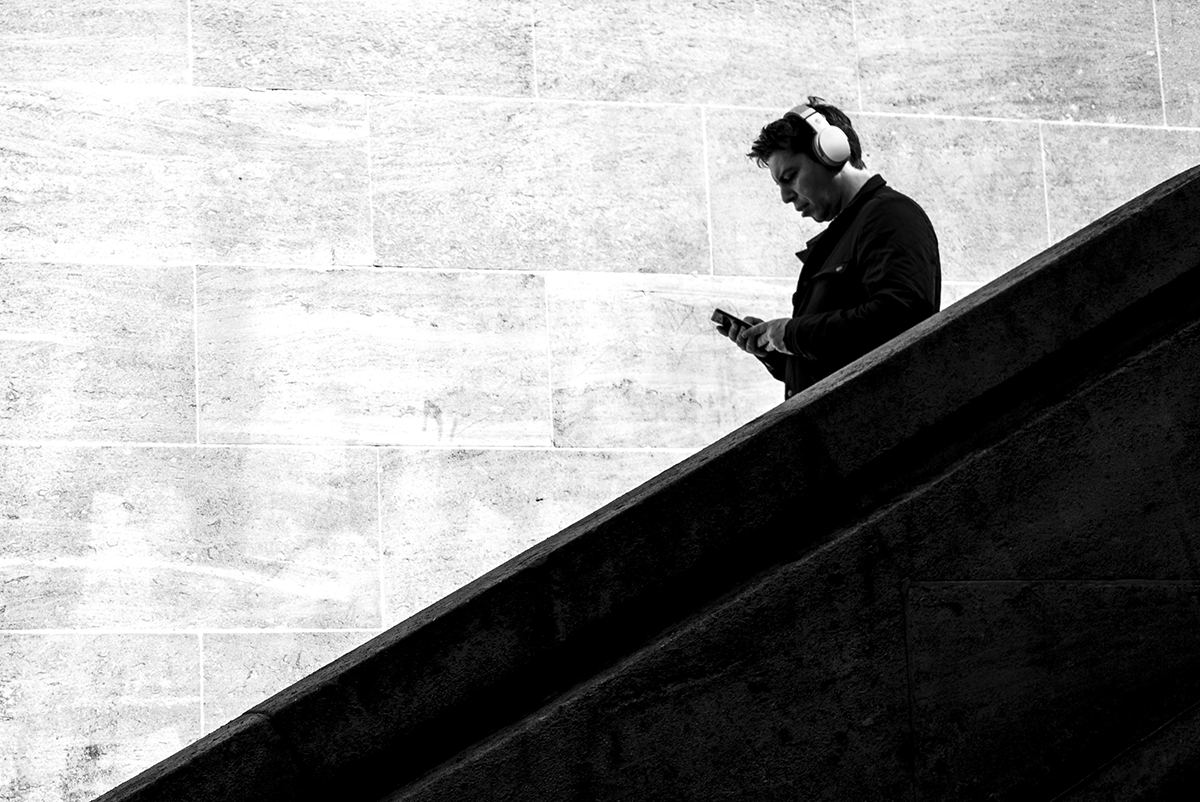Brian Lloyd Duckett is a professional street photographer who runs workshops across the UK and Europe. He shoots exclusively on Fujifilm, the X100F being his weapon of choice. In this three part guide, which aims to build your confidence, Brian gives you an insight in to what he teaches to help you become a better street photographer.
Never make eye contact
This is my ‘killer tip’ and can be a real game-changer. Avoiding eye contact is difficult (for nice people, at least!) and takes some getting used to but, as a general rule, I never make eye contact with people on the streets; one of the few exceptions would be when I need to engage with my subjects – when taking street portraits, for example.
You’ll probably be familiar with the situation: you see someone you want to photograph, you catch their eye and… the moment has gone. That split second of hesitation resulting from the eye contact has killed the opportunity and you move on, having missed the picture. The same goes for after the picture has been taken. Eye contact could lead to a conversation you would probably want to avoid – or even a confrontation. As soon as you have taken the picture look away and give the impression that your attention has been elsewhere.
I find one of the easiest ways to avoid eye contact is to wear sunglasses – it makes it impossible!
Blend in
It’s (usually) important in street photography to go ‘unseen’ and not be recognised as a street photographer. You are far more likely to achieve this if you blend in to your surroundings.
Think carefully about your environment and the people around you. Do you look as though you belong? Do you blend in? People are less likely to notice you if you look like everyone else; it is important not to stand out in any way – and is even more important not to look like a photographer. You will blend in more easily if you walk slowly and avoid sudden, jerky movements.
• Wear dark or neutral clothing – nothing too smart or too scruffy
• Dress like a local
• Hide any trappings of wealth
• Carry minimal camera gear
Less is more
Try to avoid looking like a ‘photographer’. We all see people shooting on the streets with several cameras, long lenses, huge backpacks and pouches and belts; it’s enough to make your subjects run a mile. I’m a ‘one camera, one lens’ kind of person and everything fits either into my jacket pocket or into a small shoulder bag.
Use a wide-angle lens
With a wide-angle lens you can point the camera at something which appears to be in the background whilst actually shooting the person right in front of you. The 23mm lens (35mm equivalent) of my X100F is ideal for this.
Forget people – shoot urban landscapes
If shooting people makes you so uncomfortable, I would suggest shooting wider street scenes which feature the environment more than the people. This is an under-rated genre of street photography and it can be very rewarding; it’s slower paced, more thoughtful and often technically more challenging. I run a series of Urban Landscape workshops alongside my street photography workshops, where we explore people’s relationship with the built environment.
Know your rights
You will be a more confident street photographer if you know where you stand from a legal perspective. In the UK, most of Europe and, in fact, throughout much of the world, the basic legal premise is that if you are taking pictures in public you do not need anyone’s permission to do so.
UK privacy laws are fairly loose; the key point being that ‘everyone has the right to his private and family life’. It really is a matter of common sense: if you think what you are doing may be infringing someone’s privacy, then stop doing it. On the other hand, don’t be frightened of taking someone’s photo; unless they are doing something which compromises them, you can legally photograph them freely.
Always check out the local laws if you are visiting a different country. In France, for example, privacy is a completely different ball game and the creation and / or publication of images of a person without their consent is illegal (perhaps this is why we see relatively little street photography in such a photogenic city as Paris). In Germany, there is a ‘right to one’s own image’ principle, which aims to strike a balance between personal privacy and freedom of speech.
Some countries take a stricter approach. In Hungary, for example, if you take a picture on the streets you are technically breaking the law if someone randomly wanders into shot, under a new civil code that outlaws taking pictures without the permission of every single person in the photograph.
If someone tells you that you can’t take photos on the street because it’s illegal or that you need permission, remember that in the UK it isn’t and you don’t.
Finally . . .
Here’s a brief summary of my thoughts on the topic of street photography:
• Don’t punish yourself – remember that we do this because we enjoy it! For some of us, fear will always be a part of street photography to a greater or lesser degree. If it troubles you that much, find a type of street photography you are more likely to enjoy such as urban landscapes.
• Practice not making eye contact – before, during and after taking the shot – it will boost your confidence.
• Look at the work of some great street photographers who don’t feature people so prominently in their work such as Ernst Haas, Saul Leiter, Fan Ho and Eugene Atget – and see if they inspire you.
• Get out and shoot more. The more you do it, the more relaxed and comfortable you will feel.
• Shoot with a ‘buddy’ – many of us will feel more confident if we’re not alone.
• It’s not just about people – try abstract street photography.
Missed the first two parts of this series? Read part 1 and part 2 for more street photography tips.
**Please note that the views and opinions expressed in this article are that of the author.**



















































